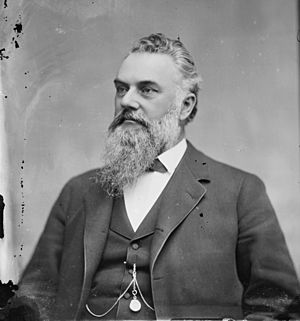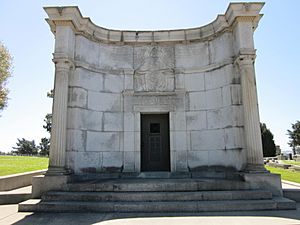James Graham Fair facts for kids
Quick facts for kids
James Graham Fair
|
|
|---|---|
 |
|
| United States Senator from Nevada |
|
| In office March 4, 1881 – March 3, 1887 |
|
| Preceded by | William Sharon |
| Succeeded by | William M. Stewart |
| Personal details | |
| Born | December 3, 1831 Clogher, Ireland |
| Died | December 28, 1894 (aged 63) San Francisco, California |
| Resting place | Holy Cross Cemetery, Colma, California |
| Nationality | American |
| Political party | Democratic |
| Spouse | Theresa Rooney (divorced) |
| Children | Theresa Fair Oelrichs James Fair Jr. Charles Lewis Fair Virginia Fair Vanderbilt |
| Residences | Geneva, Illinois, Virginia City, Nevada, San Francisco, California |
| Occupation | Prospector, mine supervisor, real estate developer, railroad builder, Senator |
| Known for | Being one of the "Bonanza Kings" |
| Net worth | USD $45 million at the time of his death (approximately 1/280 of US GNP) |
| Cause of death | Diabetes mellitus, Bright's disease |
James Graham Fair (December 3, 1831 – December 28, 1894) was an Irish immigrant who came to the United States. He became a very successful mining engineer and businessman. His investments in silver mines in Nevada made him a millionaire. He was one of the famous "silver kings" who got rich from the Comstock Lode. Later, Fair became a real estate investor and built railroads in California. In 1881, he was elected as a U.S. Senator for Nevada.
Contents
Early Life and Mining Success
James Fair was born into a poor Irish family in Clogher, County Tyrone. In 1843, he moved to the United States with his father. He grew up on a farm in Illinois and learned a lot about business.
In 1850, he moved to California. There, he looked for gold in the Feather River area. He then focused on Nevada, where he ran a stamp mill (a machine that crushes ore) on the Carson River. He also worked as a mine superintendent (a manager) in the Comstock Lode region. In 1867, he became the superintendent of the Hale and Norcross Mine in Virginia City, Nevada.
Fair teamed up with three other Irishmen: John William Mackay, and saloon owners James C. Flood and William S. O'Brien. Their company was called Flood and O'Brien, but people often called them the "Bonanza Firm". These four men made huge amounts of money from shares in silver mines on the Comstock Lode. This was the first major silver discovery in the United States. Over 20 years, the Comstock Lode produced more than $100 million.
The partners managed many mines on the Comstock. Their biggest success came in 1873. Miners in their Consolidated Virginia mine found a huge amount of ore. This discovery became known as "the big bonanza."
Fair used his share of the money to invest in railroads and real estate. This made his personal fortune grow to $50 million. People knew Fair was a skilled mine manager and a smart businessman. However, he was not always well-liked and was sometimes called "Slippery Jim." He invested much of his earnings from the Comstock in railroads and properties in San Francisco. Fair and Mackay also owned the Nevada Bank of San Francisco. For a time, this bank was the largest in America during the silver boom.
Building Railroads
In 1876, James Fair and some partners started the South Pacific Coast Railroad. This was a "narrow-gauge" railroad, meaning its tracks were closer together than standard tracks. The line began near what is now Newark. It ran down the east side of San Francisco Bay, through San Jose and Los Gatos. It continued south over the Santa Cruz Mountains.
Building this part of the railroad was a huge job. It involved digging a 6,200-foot tunnel, another 5,000-foot tunnel, and six shorter ones. About 600 Chinese workers helped clear land, level the ground, lay tracks, and dig tunnels. Thirty-one workers died during the tunneling work, mostly from explosions of underground natural gas. At its southern end, the railroad bought the Santa Cruz & Felton Railroad in Felton. The mountain section of the line was finished in May 1880.
The South Pacific Coast Railroad was successful right away and quickly made money. In 1886, the Southern Pacific bought the railroad for six million dollars. Southern Pacific later changed the tracks to standard gauge. They operated the line until 1940, when the mountain section was no longer used.
Political Career
In 1881, the Nevada legislature elected Fair to the U.S. Senate. He was not very interested in being in Washington, D.C. While in the Senate, he supported issues related to silver. At that time, there was a movement to stop using silver as a main form of money. Fair served one term as a senator. After his term ended in 1887, he moved back to San Francisco.
Family Life
In 1861, Fair married Theresa Rooney. She had been running a boarding house. They divorced in 1883. Theresa raised their four children on her own and received a large amount of money in the divorce settlement.
In 1890, his oldest daughter, "Tessie", married Hermann Oelrichs. This was a very grand wedding in San Francisco. James Fair stayed in his hotel suite and did not attend. However, he still gave Tessie a million dollars as a wedding gift.
James Fair is buried in Holy Cross Cemetery in Colma, California. His will left $40 million in a trust for his two daughters, Theresa "Tessie" Alice Fair and Virginia Graham Fair. Virginia later married William Kissam Vanderbilt II. He also left money to his surviving son, Charles Lewis Fair. Charles died in a car accident in France in 1902 at age 35.
Legacy
The Fairmont San Francisco hotel was built as a grand tribute to James Fair. His daughters, Theresa Fair Oelrichs and Virginia Fair Vanderbilt, built it and named it in his honor. Construction started in 1902. However, they sold their ownership in 1906, just days before the 1906 San Francisco earthquake.
James Fair is also remembered in Santa Cruz, California with Fair Avenue. In San Francisco, there is also a Fair Avenue in Bernal Heights.
See also
 In Spanish: James Graham Fair para niños
In Spanish: James Graham Fair para niños


